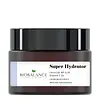What's inside
What's inside
 Key Ingredients
Key Ingredients

 Benefits
Benefits

 Concerns
Concerns

 Ingredients Side-by-side
Ingredients Side-by-side

Water
Skin ConditioningGlycerin
HumectantNiacinamide
SmoothingCaprylic/Capric Triglyceride
MaskingCetearyl Alcohol
EmollientGlyceryl Stearate
EmollientPropylene Glycol
HumectantPanthenol
Skin ConditioningCyclopentasiloxane
EmollientDimethicone
EmollientButyrospermum Parkii Butter
Skin ConditioningOryza Sativa Bran Oil
EmollientDiacetyl Boldine
Skin ConditioningCeteareth-25
CleansingCeteareth-20
CleansingSodium PCA
HumectantTocopheryl Acetate
AntioxidantPotassium Cetyl Phosphate
EmulsifyingCeteareth-12
EmulsifyingCetyl Palmitate
EmollientAcrylates/C10-30 Alkyl Acrylate Crosspolymer
Emulsion StabilisingPhenoxyethanol
Preservative3-O-Ethyl Ascorbic Acid
Skin ConditioningGlycyrrhiza Glabra Root Extract
BleachingEthylhexylglycerin
Skin ConditioningPalmitoyl Sh-Octapeptide-24 Amide
Skin ConditioningXanthan Gum
EmulsifyingPolyvinyl Alcohol
Palmitoyl Sh-Tripeptide-5 Norisoleucyl Sh-Nonapeptide-1
Skin ConditioningLactic Acid/Glycolic Acid Copolymer
Skin ConditioningSodium Hydroxide
BufferingAllantoin
Skin ConditioningTetrasodium EDTA
Caprylyl Glycol
EmollientGlyceryl Caprylate
EmollientPhenylpropanol
MaskingWater, Glycerin, Niacinamide, Caprylic/Capric Triglyceride, Cetearyl Alcohol, Glyceryl Stearate, Propylene Glycol, Panthenol, Cyclopentasiloxane, Dimethicone, Butyrospermum Parkii Butter, Oryza Sativa Bran Oil, Diacetyl Boldine, Ceteareth-25, Ceteareth-20, Sodium PCA, Tocopheryl Acetate, Potassium Cetyl Phosphate, Ceteareth-12, Cetyl Palmitate, Acrylates/C10-30 Alkyl Acrylate Crosspolymer, Phenoxyethanol, 3-O-Ethyl Ascorbic Acid, Glycyrrhiza Glabra Root Extract, Ethylhexylglycerin, Palmitoyl Sh-Octapeptide-24 Amide, Xanthan Gum, Polyvinyl Alcohol, Palmitoyl Sh-Tripeptide-5 Norisoleucyl Sh-Nonapeptide-1, Lactic Acid/Glycolic Acid Copolymer, Sodium Hydroxide, Allantoin, Tetrasodium EDTA, Caprylyl Glycol, Glyceryl Caprylate, Phenylpropanol
Water
Skin ConditioningGlycerin
HumectantCaprylic/Capric Triglyceride
MaskingCoco-Caprylate/Caprate
EmollientGlyceryl Stearate
EmollientButylene Glycol
HumectantCetearyl Alcohol
EmollientPolyglyceryl-6 Palmitate/Succinate
EmulsifyingCeramide NP
Skin ConditioningLinoleic Acid
CleansingLinolenic Acid
CleansingAcacia Senegal Gum
MaskingXanthan Gum
EmulsifyingTocopherol
AntioxidantTetrasodium Glutamate Diacetate
Sorbitan Caprylate
EmulsifyingPropanediol
SolventBenzoic Acid
MaskingWater, Glycerin, Caprylic/Capric Triglyceride, Coco-Caprylate/Caprate, Glyceryl Stearate, Butylene Glycol, Cetearyl Alcohol, Polyglyceryl-6 Palmitate/Succinate, Ceramide NP, Linoleic Acid, Linolenic Acid, Acacia Senegal Gum, Xanthan Gum, Tocopherol, Tetrasodium Glutamate Diacetate, Sorbitan Caprylate, Propanediol, Benzoic Acid
Ingredients Explained
These ingredients are found in both products.
Ingredients higher up in an ingredient list are typically present in a larger amount.
This ingredient is an emollient, solvent, and texture enhancer. It is considered a skin-softener by helping the skin prevent moisture loss.
It helps thicken a product's formula and makes it easier to spread by dissolving clumping compounds.
Caprylic Triglyceride is made by combining glycerin with coconut oil, forming a clear liquid.
While there is an assumption Caprylic Triglyceride can clog pores due to it being derived from coconut oil, there is no research supporting this.
Learn more about Caprylic/Capric TriglycerideCetearyl alcohol is a mixture of two fatty alcohols: cetyl alcohol and stearyl alcohol. It is mainly used as an emulsifier. Emulsifiers help prevent the separation of oils and products. Due to its composition, it can also be used to thicken a product or help create foam.
Cetearyl alcohol is an emollient. Emollients help soothe and hydrate the skin by trapping moisture.
Studies show Cetearyl alcohol is non-toxic and non-irritating. The FDA allows products labeled "alcohol-free" to have fatty alcohols.
This ingredient is usually derived from plant oils such as palm, vegetable, or coconut oils. There is debate on whether this ingredient will cause acne.
Due to the fatty acid base, this ingredient may not be Malassezia folliculitis safe.
Learn more about Cetearyl AlcoholGlycerin is already naturally found in your skin. It helps moisturize and protect your skin.
A study from 2016 found glycerin to be more effective as a humectant than AHAs and hyaluronic acid.
As a humectant, it helps the skin stay hydrated by pulling moisture to your skin. The low molecular weight of glycerin allows it to pull moisture into the deeper layers of your skin.
Hydrated skin improves your skin barrier; Your skin barrier helps protect against irritants and bacteria.
Glycerin has also been found to have antimicrobial and antiviral properties. Due to these properties, glycerin is often used in wound and burn treatments.
In cosmetics, glycerin is usually derived from plants such as soybean or palm. However, it can also be sourced from animals, such as tallow or animal fat.
This ingredient is organic, colorless, odorless, and non-toxic.
Glycerin is the name for this ingredient in American English. British English uses Glycerol/Glycerine.
Learn more about GlycerinGlyceryl Stearate is a mix of glycerin and stearic acid.
It is used to stabilize the mixing of water and oil ingredients. By preventing these ingredients from separating, it can help elongate shelf life. It can also help thicken the product's texture.
As an emollient, it helps soften skin and supports barrier-replenishing ingredients.
In cosmetics, Glyceryl Stearate is often made from vegetable oils or synthetically produced.
This ingredient may not be fungal-acne safe
Fun fact: The human body also creates Glyceryl Stearate naturally.
Learn more about Glyceryl StearateWater. It's the most common cosmetic ingredient of all. You'll usually see it at the top of ingredient lists, meaning that it makes up the largest part of the product.
So why is it so popular? Water most often acts as a solvent - this means that it helps dissolve other ingredients into the formulation.
You'll also recognize water as that liquid we all need to stay alive. If you see this, drink a glass of water. Stay hydrated!
Learn more about WaterXanthan gum is used as a stabilizer and thickener within cosmetic products. It helps give products a sticky, thick feeling - preventing them from being too runny.
On the technical side of things, xanthan gum is a polysaccharide - a combination consisting of multiple sugar molecules bonded together.
Xanthan gum is a pretty common and great ingredient. It is a natural, non-toxic, non-irritating ingredient that is also commonly used in food products.
Learn more about Xanthan Gum